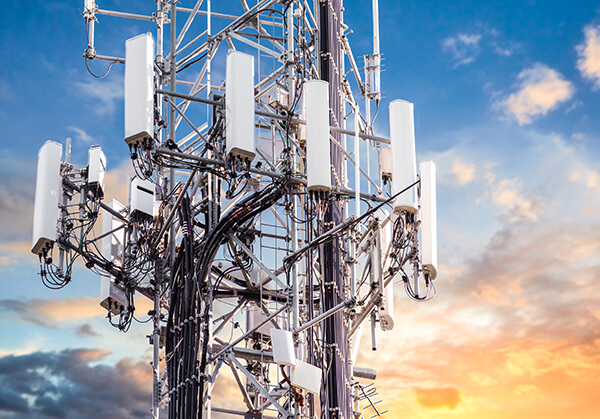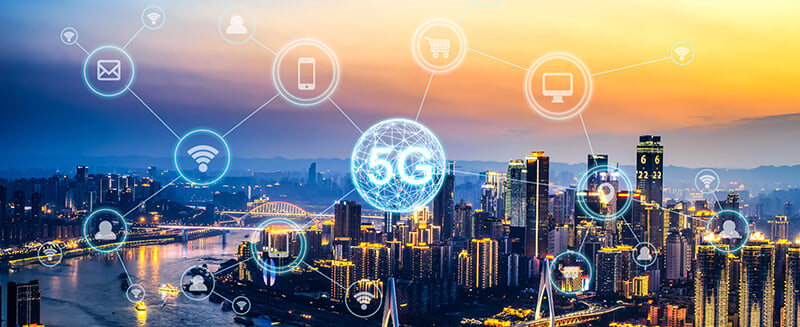與我們聯絡
與 Tek 業務代表即時對談。 上班時間:上午 6:00 - 下午 4:30 (太平洋時間)
請致電
與 Tek 業務代表即時對談。 上班時間:上午 8:30 - 下午 5:30 (太平洋時間)
下載
下載手冊、產品規格表、軟體等等:
意見回饋
5G Testing and Calibration
5G and the Future of Communication
The current dependence on wireless communications devices around the world and the ongoing need for additional wireless data from the use of smartphones and tablets has led to the development and installation of new 5G wireless networks in many areas of the world.
5G is the fifth generation of mobile broadband networks that will eventually replace the current 4G LTE services. Portions of the 5G network will operate based on similar mobile networking principles as 4G, but 5G contains wider bandwidth capabilities that can deliver better performance, faster speeds, decreased latency and improved efficiency.
5G will have the opportunity to use its wider bandwidth capability to connect virtually everyone and every device together. With 5G, not only will improved cellular phone service be available with exponentially faster download and upload speeds, it will also provide consumers with a variety of new user experiences and will expand communications and connectivity into many new industries. 5G is a global investment that will deliver a much higher degree of flexibility and scalability to mobile communications and will reap many rewards for the future.

5G Bandwidths
5G will be able to operate on a wider frequency range than 4G and its structure is centered around three major bandwidth channels, called low-band, mid-band, and high-band. Each of them has very different speeds, performance and capabilities from each other.
Low-Band
Low-band 5G operates in frequencies below 2GHz. These are the traditional cellular frequencies and they operate with the speed and capabilities of 3G and 4G. They can be broadcast across large distances but many of the channels are already being used for 4G LTE services and TV stations, so there are few channels available. Because of this, Low-band 5G will seem slow compared with the other bandwidths that are available for 5G.
Mid-Band
Mid-band 5G uses the 2GHz to 10GHz frequency range. That covers most of the existing LTE cellular and Wi-Fi frequencies. Mid-band 5G offers the best mixture of coverage range and data speeds. Most current towers have existing capabilities and broadcast range within these frequencies, so in many metro areas in the US and in many other countries, these will be the bandwidths that will carry most of the 5G data and traffic.
High-Band
High-band 5G, and the use of new millimeter-wave frequencies, is where the true advantages of 5G will be forged. This bandwidth will operate in the 20GHz to 100GHz frequency range. Although these frequencies have been used for specific wireless applications before, these frequencies have never been used for consumer-based purposes. Because these bandwidths have a large number of unused channels and capacity, users will benefit greatly from the speeds and massive amounts of data this band will be able to transfer.
High-Band 5G signal amplitudes drop off significantly with distance, so the cellular infrastructure will need to be redesigned to fully use these bandwidths. Cellular companies will need to replace the base stations that are seen dotting the landscape today with numerous lower-power base stations to provide the signal strengths that will be required.
5G Improvements and Uses
5G will bring about many changes throughout the next decade and will change the way we interact with technology on a day-to-day basis,
With its ultra-fast speeds and unprecedented response times, the complex information that can be transmitted through 5G’s High Band frequencies has the potential for and virtually unlimited possibilities for growth and advancement in nearly every industrial sector of the economy.
From health, transportation, manufacturing and smart devices to VR applications, many of the most advanced technological uses of 5G are just now being designed and will take years before they become a staple of modern-day life.
Improved Broadband and Cellular Capabilities
The faster speeds and large amounts of unused bandwidth of 5G’s High Band range will be very important in the continued use and growth of commercial broadband service. In many metropolitan areas, capacity for 4G services are running low and users have experienced reduced speeds during certain times of the day.
Public Health and Safety
5G will drastically change how metropolitan areas will use technology. Communication with various cameras and sensors across city streets can alert authorities, utility companies and emergency responders to various situations needing assistance from traffic issues to natural disasters to allow them to operate more efficiently and respond more quickly.
5G will also play a key role in the future of health care. Improvements in telemedicine, patient monitoring, virtual physical therapy treatments and remote surgeries will soon be commonplace.
Transportation
5G will be instrumental in the future development of autonomous vehicles and traffic control. Autonomous vehicles will be able to communicate with other vehicles on the road and share information about accidents, traffic slowdowns or road conditions. The advanced learning through these vehicle-to-vehicle communications could make driving safer and save lives.
Smart traffic lights could be developed to manage the traffic depending on the traffic conditions at the time to save fuel and provide more efficient traffic flow through busy city streets.
Smart Devices
Although a number of different types of smart devices are currently being used in many homes and businesses, they require a large amount of resources and the number of devices that can connect to each other is limited due to data restrictions. 5G will make communication between smart devices seamless and efficient and allow for hundreds of devices to be connected through a single base station.
Remote Industrial Control
With the improved speeds and latency of 5G, the control of industrial machinery and robotics remotely will become widely available. Nearly any type of equipment can be operated by technicians in a control room anywhere within a facility or even operated anywhere in the world. This can be especially useful for working in hazardous environments or reducing the risk of human injuries when operating dangerous equipment.

5G Testing
The proper testing of 5G networks will play a vital role in its development, deployment, and operation as 5G expands into its full potential. 5G testing will need to encompass more than just verifying the coverage density and download speeds.
New 5G networks will need to meet testing and characterizing demands that are unparalleled with respect to network speeds, bandwidth, and synchronization. This will require the testing of new technologies, components and including multiple-input, multiple-output (MIMO) antenna arrays and the testing and generation of high GHz, millimeter-wave frequencies.
The 3rd Generation Partnership Project, or 3GPP, has released a preliminary standard in the development of 5G, called 5G New Radio (5GNR). This standard identifies two 5GNR frequency ranges, FR1 that operates between 450 MHz and 6 GHz and FR2 that operates between 24.25 GHz and 52.6 GHz. Initially, 5G systems will utilize the sub-6 GHz frequencies and the 28 GHz and 39 GHz frequencies.
Various types of Vector Signal Analyzers and other Signal and Spectrum Analyzers/Generators will be the main instrument types to test the performance of 5G systems. This equipment will be able to test and characterize the wideband components and wireless communication systems that support the 5G bandwidth requirements and can set up complex measurements quickly and easily. With bandwidths and output capabilities over 50GHz, the testing equipment used to evaluate and calibrate the 5G networks will need to push the boundaries of the testing equipment available on the market today.
As future 5G capabilities and the network equipment are being developed, new measurement requirements and technologies must be identified to anticipate the future operational needs of the 5G infrastructure. The use of cloud-based test equipment and software automation will bring added complexity and technical challenges to developing network test solutions. MIMO will require a large number of antennas and special robotics are also being developed for precise antenna positioning to provide new levels of measurement precision for 5G system testing.
5G Test Equipment Calibration
From Digital Sampling Oscilloscopes, Power Meters, Vector Signal Generators, and Network Spectrum Analyzers the RF test equipment required to calibrate the variety of Signal and Spectrum Analyzers/Generators will need to initially have capabilities to measure and generate signals to 40GHz for the current 5GNR standards but will need the capability to ramp up to higher frequencies as 5G equipment continues to evolve and advanced beamforming and mmWave systems are designed.
Among the many RF tests that must be performed on 5G testing equipment are:
- AM & FM Accuracy, Distortion and Frequency Response
- Phase Modulation Accuracy, Distortion and Frequency Response
- Spurious Emissions Measurement
- Digital Modulation Level Accuracy
- Pulse and Burst Modulation On/Off Ratio
- Harmonic & Subharmonic Distortion
- Channel Power Level Accuracy
- DCFM Frequency Offset
- Timebase Aging Rate
The RF calibration equipment must provide amplitude, modulation and phase generation over the testing instrument’s full bandwidth at any operating frequency. All of these tests must be made with a high degree of accuracy and repeatability and must provide traceability to primary reference standards.
As with all advancements in technology, the calibration of 5G testing equipment will require significant advances in the performance of microprocessor technology, software design and hardware interfaces to create the highest accuracies for the calibration of 5G testing equipment.

